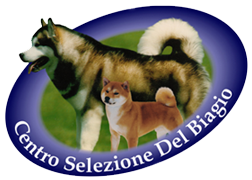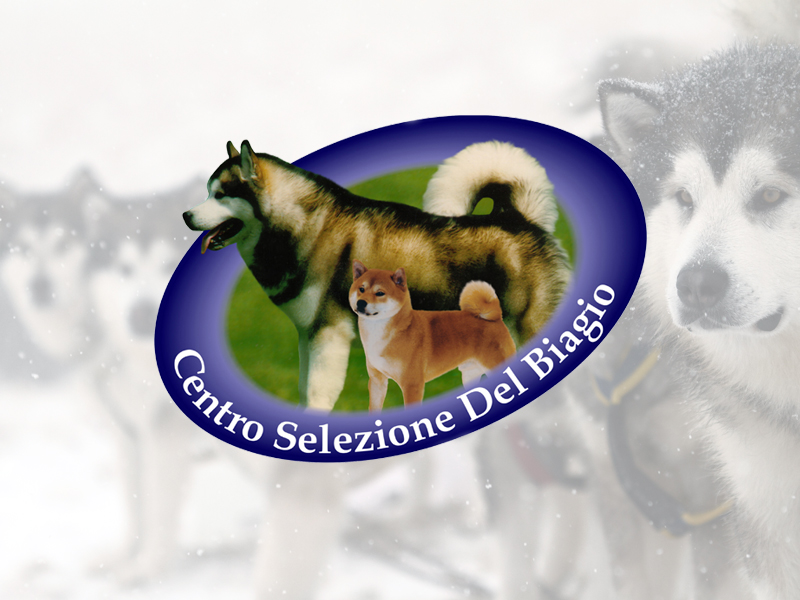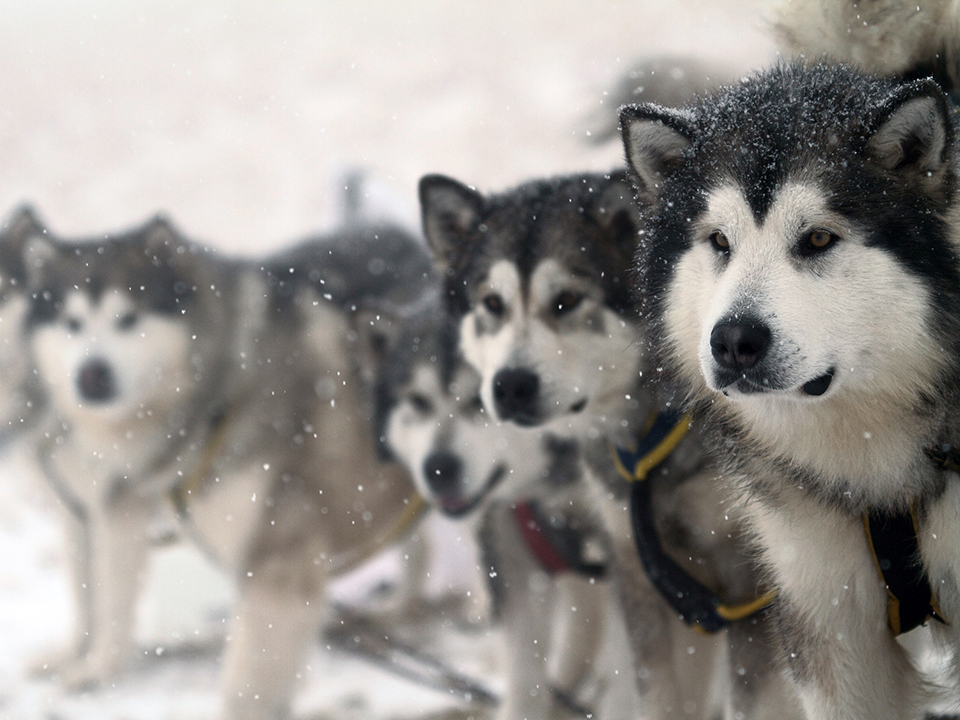
DOGS OF THE GREAT NORTH
Yes, we agree: but let's not limit ourselves to the usual stereotypes. The Malamute knows how to be a true "easy going", as well as a very elegant member of the push environment. But the role he does best is always that of the perfect… cuddling dog, because the Malamute feels above all a companion and a friend of those he considers "dogs a bit strange – two legged and without tails". The Alaskan Malamute takes its name from the Inuit Mahlemiut tribe, which began its selection in very distant times. In the Eskimo language "miut" means "people", while the word "mahle" does not know the translation. It is likely that it was a geographical name and therefore Mahlemiut would mean "people of Mahle".
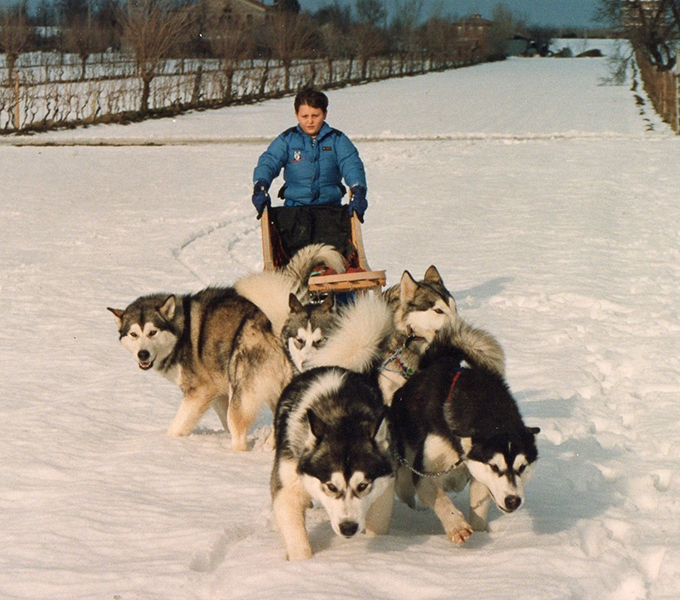
This population lived in the territory of the Kotzebue Sound, between the Kobuk River and the Noatak River. At that time, Alaska was a Russian possession and remained so until 1867, when it passed to the United States. The Mahlemiuts and the other Arctic peoples did not even notice the political change: they continued to live the same life as ever because the lands in which they lived were too inhospitable to interest someone who had not been born there.
In 1896, however, everything would change: gold was discovered along the Klondike river and thirty thousand men invaded the Great North, dazzled by the mirage of wealth. Since gold could be sought only in the short periods when ice did not completely block roads and rivers, for the rest of the time the seekers were bored to death. In addition to alcohol, the greatest antidote to boredom was represented by races and bets, in which dogs played an important part. The story of the Siberian Husky tells us that these little dogs, mocked with the name of "Nordic mice", soundly beat the mestizos in all races of speed and resistance.
The Malamutes, on the other hand, showed the green mice to everyone in the heavy towing tests and in those of moving large weights. This type of race is still held today in America and our race continues to excel, setting records on record.
After the gold rush era, sled dog competitions remained very popular. Thus, in 1923, a young Massachusetts teacher read a newspaper that talked about it. She thought that a group of sled dogs would be an exceptional attraction for the carnival of her city and decided to get one. Eva Seeley, known as "Short" because of her small size, still did not know that she would get madly in love with those dogs and that together with her husband Milton she would become the biggest American breeder of Siberian Husky and Alaskan Malamute.
Eva met all the greatest sled dog champions of the time. It was thanks to her ability as a breeder (but also promoter) that the American Kennel Club recognized the Siberian Husky in 1930 and the Alaskan Malamute in 1935. In that year the first official Malamute in history was recorded in the book: Gripp of Yukon, who would later become the first American Champion of the Breed. "Short" Seeley, since the beginning of his activity, had more Siberian than Malamute; in fact this breed was already disappearing along with its people. The tribe of Mahlemiut lived almost exclusively on hunting and fishing; its main source of livelihood was the caribou, but this animal, inexplicably, had moved away from the Kotzebue in the mid-nineteenth century. Eva Seeley's Malamutes had honor and glory, accompanying Byrd's first expedition to Antarctica and then being "enrolled" by the army at the beginning of World War II; but it was a glory paid dearly, because at the end of the war the race was practically decimated. His story begins again only in 1947, with three different bloodlines:
The first, called "KOTZEBUE", descended directly from the dogs of Short Seeley.
The second, called "M'LOOT", came from the Yukon territory and was imported by Paul Voelker.
On the third line, the least known, was given the name "HINMANN-IRWIN", from the names of those who disclosed it.
He had a rather brief history, but he did however feel his influence on the development of the breed.

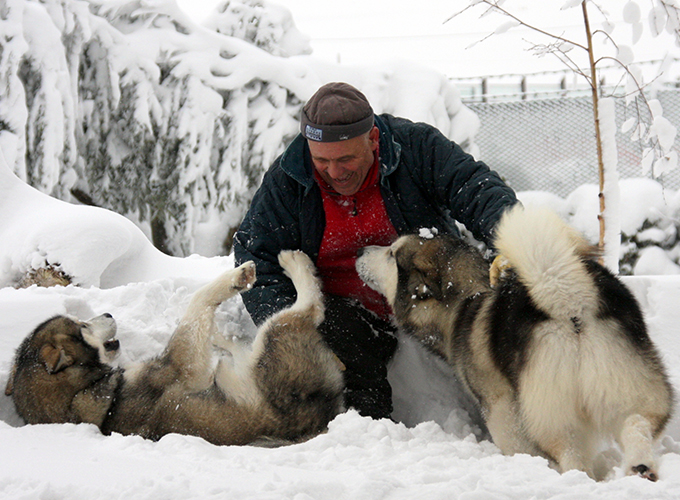
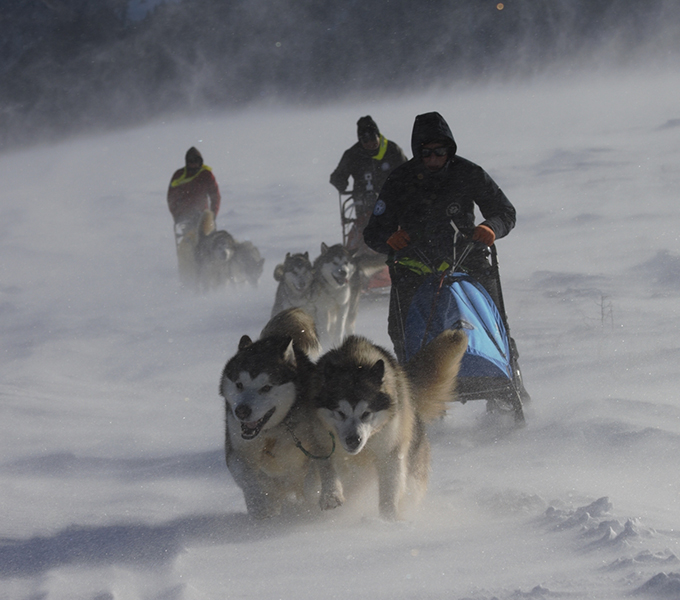
Kotzebue and M'Loot were quite different from each other: the pure Kotzebue had a beautiful head, but low stature and a single color, the gray wolf. The M'Loots were taller but had tighter chest, long ears and sharp faces. Moreover the rear angles were less accentuated, so the gait was less loose than that of the current subjects. Unlike the Kotzebues, the M'Loots had a great variety of colors, including red. Finally, the character of the M'Loots was sweeter, while the Kotzebues tended to be a little aggressive. For a long time the two lines were bred in purity: then Robert Zoller, owner of the Husky-Pak affix, decided to cross them together and obtained really amazing results. Since then the two lines have become increasingly connected to each other and almost all modern pedigrees include both. Primitive type dogs like the Malamute are very "wolves", because the man intervened only partially on the selection of their psychic characteristics. He erased all traces of aggression, making them docile and friendly, but he never undermined their instinct for social and highly hierarchical animals, just like the ancestor wolf.
When a Malamute covers some females, it thinks it is the one that among the wolves is called "alpha male": the highest grade and the only one that can reproduce. For this he believes that all the puppies of his pack are his children and he is "forced" to be kind to these little assatinates who pass on his precious genetic patrimony (... even if every now and then a loud snarl escapes us; every patience has a limit! )
Newborn puppies are completely blind and deaf. The only sense that guides them is the sense of smell and the only smell I can smell is that of the mother, which means "food" and therefore "life". After a week, in practice, only the dimensions have changed: the only imperatives remain "to eat" and "to sleep". After another couple of weeks, everything changes: now the puppies are real dogs (or almost), in possession of a thousand new faculties. They see, hear and walk, but certainly, at this age, they could not get away from their mother and herd. For this reason, Mother Nature sent the puppies a precious message: "everything you can touch, see and smell in this period of your life belongs to your own species". The puppy understands this message in what ethologists call "the period of imprinting", which goes from three to seven weeks of life. Therefore, for all this time the man must "bluff", that is to make oneself touch, see and smell from the puppies, convincing them that we all belong to the same species. If this were not the case, once adults the dogs would evaluate us with the only two alternatives that a wolf knows: either predators to fear and flee, or prey to attack and possibly eat. Certainly they would never become the sweet companions of life and work that instead have always been for man.
Let's return to the behavior of puppies with an adult male: the attempt to suck is simply a mistake (one must also experience these things ...) while the assault on the muzzle is not a game nor a simple sign of affection. In reality it is a simple invitation to regurgitate semi-digested food, because this is how the puppies are fed at the start of weaning. Wolves do it and so do many Northern Breeds. Since this is a declaration of total dependence, this gesture has also taken on a meaning of surrender and submission between adults. That's why our dog, to celebrate us, jumps towards our face.
Another sign of submission is to show the belly. This too is found in the adult, who performs it to tell us: "I recognize you as my superior". As can be seen, it is not difficult to understand the "canese", especially that of the more lupine breeds, which bark little and express themselves very much with the body language. The bark is a consequence of domestication; in nature it is rarely heard, because wild animals try to make as little noise as possible. It is not a wise idea to let any predators know where the pack is, while it is permissible to howl if a member remains isolated, to make them understand how to reach others. Living with a Nordic dog means living with an almost wolf: very sweet and very reliable, so much so that we can entrust our children to him without the slightest fear, but with the mind of a wolf from a social and hierarchical point of view.
This means that in order for us to respect and obey the dog we will have to learn the difficult art of the "pack leader": a role that NEVER is achieved by force, but with firmness, consistency and reliability. It is not an easy challenge, because the Malamute is a very demanding dog, but whoever manages to gain the respect of it will have the immense satisfaction of a companion who obeys him and who never leaves his side, always keeping his eyes on him waiting for his command or approval. This translates into a dog that can follow us anywhere without a leash, that rushes from us as soon as we call it ... .. and that manages to hold back its predatory instincts, merely "looking" at what it is not allowed to "touch" .
With those who do not succeed in being a good pack leader, on the contrary, the Nordic dog will remain very sweet and lovable, but will not recognize the authority of the master and will do whatever he likes.
Does an Alaskan Malamute near to the sea really make sense, or at least far from the large ice in which it was born?
The time has come to take this problem seriously. Let's start by saying that the Malamute fur does not cause it any discomfort if the thermometer rises: it does not simply keep it "warm", but has a thermo-insulating function which therefore protects the dog from both cold and heat. The Malamute does not suffer from the heat more than a German shepherd and certainly runs less risk than a boxer or a bulldog, even though these have short hair. Once the skin is protected, the thickness of the fur affects relatively the well-being of the dog; what really matters is the ability to cool the air inhaled through the long, wide and spacious nasal bridge. For this reason the Malamute is perfectly equipped to live at any latitude. It must be remembered that northern breed dogs can "survive" the polar temperatures thanks to the defenses given them by nature, but this does not mean that they prefer them or even that they "like" them! A dog that has to fight all its life against the grip of ice will certainly not be better than a dog that lives at milder temperatures; indeed, the latter will have a longer and healthier life, because it will use the energies that its Arctic colleague disperses in a different way for the sole purpose of protecting themselves from the cold. The average life of an Eskimo Malamute was six to seven years; that of a modern city dog is ten to fifteen years old and this speaks volumes about the alleged "need" to live below zero.
Longer life, however, does not necessarily mean "good quality" of life itself; we will have to think about this, remembering that the Malamute is an intelligent and dynamic working dog. If we have the chance, we can teach our dog to pull; he likes it very much, he was born for this and he does it with joy. But if we live away from the snow, we remind you that sledging is not essential: you can have fun with a cart or a simple mountain bike! And if we don't have a particularly sporting spirit, let's not worry: there are a thousand ways to make our Malamute run and let it vent its energies, alone or in company. He loves human company very much, especially that of someone like him who wants to play; but being a social animal, he also likes to be with members of his species.
If we have a male, as for all males in the world, it is better to choose friends of the opposite sex; but the Malamute tends not to look for a fight, on the contrary, he loves human beings so much that sometimes he does not even pay attention to the other dog, preferring to exchange effusions with the owner. On the other hand, if it is provoked, our northern dog will not back out; better not to take unnecessary risks. A bit dog and a little wolf, primitive and very astute, playful and very tender, the Malamute is not a dog for everyone; there will always be those who ask us "what is the use of" a dog like this, if we do not attach it to a sled. The poor people do not know what it means to have a piece of uncontaminated nature beside them; they do not know what it means to look at their dog's eyes and feel themselves flying among endless expanses of ice, of solitude, of peace.
Needless to explain: those who do not know will never understand. But those who love Malamutes ... "know", full stop. He also feels the spirit of the wolf within himself and knows that choosing this breed will not be limited to "owning a dog". He will have a brother next to him.

